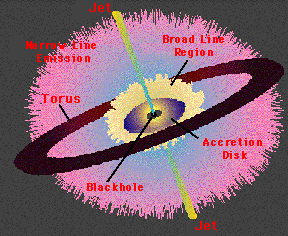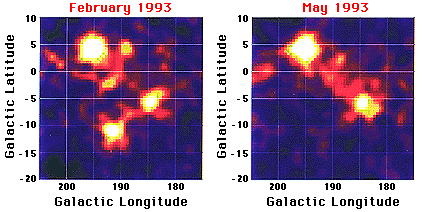Active galaxies are galaxies which have a small core of emission embedded in an otherwise typical galaxy. This core may be highly variable and very bright compared to the rest of the galaxy. Models of active galaxies concentrate on the possibility of a supermassive black hole which lies at the center of the galaxy. The dense central galaxy provides material which accretes onto the black hole releasing a large amount of gravitational energy. Part of the energy in this hot plasma is emitted as x-rays and gamma rays.
For "normal" galaxies, we can think of the total energy they emitas the sum of the emission from each of the stars found in the galaxy. Forthe "active" galaxies, this is not true. There is a great deal moreemitted energy than there should be... and this excess energy is found in theinfrared, radio, UV, and X-ray regions of the electromagnetic spectrum. Theenergy emitted by an active galaxy (or AGN) is anything but "normal". So what is happening in these galaxies to produce such an energetic output?
There are several types of active galaxies: Seyferts, quasars, andblazars. Most scientistsbelieve that, even though these types look very different to us, they arereally all the same thing viewed from different directions! Quasars are activegalaxies which are all very, very, very far away from us. Some of the quasarswe have seen so far are 12 billion light-years away! Blazars are verybright in the radio band, which results from looking directly down ajet which is emitting in synchrotron radiation. On the other hand, if the jet is not pointing toward youat all, and the dusty disk of material which lies in the plane of thegalaxy is in the way, you would see justwhat we see from the Seyferts. By measuring their redshifts, we findthat Seyferts are much closer to us thanquasars or blazars.
Active galaxies are intensely studied at all wavelengths. Since theycan change their behavior on short timescales, it is useful to studythem simultaneously at all energies. X-ray and gamma-ray observations haveproven to be important parts of this multiwavelength approach since manyhigh-energy quasars emit a large fraction of their power at such energies. X-rays can penetrate outward from very nearthe center of a galaxy. Since that is where the "engines" of AGN arelocated, X-rays provide scientists with unique insights into the physicalprocesses occurring there. In addition, gamma-ray observations alone canprovide valuable information on the nature of particle acceleration in thequasar jet, and clues as to how the particles interact with theirsurroundings.

A diagram of an active galaxy, showingthe primary components.
Observations of Seyfert galaxies in gamma rays are also important for studies of the cosmic gamma-ray background. Even in regions of the sky wherethere are no point sources, a faint gamma-ray glow is detectable. It may be that this glow is the sum of many faint galaxies or perhaps a more exotic process. Studies of individual Seyfert galaxies can be combined with a model of how such objects are distributed in the Universe to compare to the diffuse gamma-ray background. In this way, astronomers not only learn about the interesting AGN phenomena, but learn more about the general nature of the Universe as a whole.

An artists concept of an active galactic nucleus
For "normal" galaxies, we can think of the total energy they emitas the sum of the emission from each of the stars found in the galaxy. Forthe "active" galaxies, this is not true. There is a great deal moreemitted energy than there should be... and this excess energy is found in theinfrared, radio, UV, and X-ray regions of the electromagnetic spectrum. Theenergy emitted by an active galaxy (or AGN) is anything but "normal". So what is happening in these galaxies to produce such an energetic output?
There are several types of active galaxies: Seyferts, quasars, andblazars. Most scientistsbelieve that, even though these types look very different to us, they arereally all the same thing viewed from different directions! Quasars are activegalaxies which are all very, very, very far away from us. Some of the quasarswe have seen so far are 12 billion light-years away! Blazars are verybright in the radio band, which results from looking directly down ajet which is emitting in synchrotron radiation. On the other hand, if the jet is not pointing toward youat all, and the dusty disk of material which lies in the plane of thegalaxy is in the way, you would see justwhat we see from the Seyferts. By measuring their redshifts, we findthat Seyferts are much closer to us thanquasars or blazars.
Active galaxies are intensely studied at all wavelengths. Since theycan change their behavior on short timescales, it is useful to studythem simultaneously at all energies. X-ray and gamma-ray observations haveproven to be important parts of this multiwavelength approach since manyhigh-energy quasars emit a large fraction of their power at such energies. X-rays can penetrate outward from very nearthe center of a galaxy. Since that is where the "engines" of AGN arelocated, X-rays provide scientists with unique insights into the physicalprocesses occurring there. In addition, gamma-ray observations alone canprovide valuable information on the nature of particle acceleration in thequasar jet, and clues as to how the particles interact with theirsurroundings.

A diagram of an active galaxy, showingthe primary components.
Seyfert Galaxies
Of the two types of Active Galactic Nuclei (AGN) which emit gamma rays, Seyfert galaxies are the low-energy gamma-ray sources. Seyfert galaxies typically emit most of their gamma rays up to energies of about100 keV and then fade as we observe them at higher energies. Early gamma-ray observations of Seyfert galaxies indicated that photons were detected up to MeV energies, but more sensitive observations have cast doubt on this possibility. At these low gamma-ray energies, the emission is usually a smooth continuation of the X-ray emission from such objects. This generally indicates that the physical processes creating the gamma rays are thermal processes similar to thoseresponsible for emission from galactic black hole sources. As a result, gamma-ray studies of the high-energy spectrum and variability can give scientists important information about the physical environment in the AGN.Observations of Seyfert galaxies in gamma rays are also important for studies of the cosmic gamma-ray background. Even in regions of the sky wherethere are no point sources, a faint gamma-ray glow is detectable. It may be that this glow is the sum of many faint galaxies or perhaps a more exotic process. Studies of individual Seyfert galaxies can be combined with a model of how such objects are distributed in the Universe to compare to the diffuse gamma-ray background. In this way, astronomers not only learn about the interesting AGN phenomena, but learn more about the general nature of the Universe as a whole.

An artists concept of an active galactic nucleus
Quasars
One of the most remarkable trends in gamma-ray astronomy in recentyears has been the emergence of high-energy gamma-ray quasars as an important component of the gamma-ray sky. At gamma-ray energies, these active galaxies are bright; they are highly variable at all energies. Unlike the Seyfert type AGN, most of these sources arepreferentially detected at high energies, usually 100 MeV or more. In fact, they have been detected above 1 GeV, and some up to several TeV! Given the large distances to these objects and the strong emission of high-energy gamma rays, these are the most powerful particle accelerators in the Universe. Over 50 high-energy quasars are known at this time.Some appear as fuzzy stars that can be seen with large amateur telescopes. Many astronomers believe that Seyfert galaxies and high-energyquasars are basically the same type of objects, but we are simply viewingthem differently. Radio observations of AGN often show powerful jets, streamsof particles coming from the central source -- like water from a spigot.Charged particles are accelerated to nearly the speed of light in these jets. In the unified view of active galaxies,high-energy quasars are being viewed with the jet pointed towards uswhich allows us to see the resulting energetic radiation. With Seyfert galaxies, we are viewing from the side and do not see the very high-energyradiation which is traveling down the jet.  |
| The region of the sky containing one of the high-energy quasars, PKS 0528+134, is shown at two different times using the EGRET instrument on the Compton Gamma-Ray Observatory. These active galaxies are highly variable, strongly emitting gamma-rays sometimes, disappearing at other times. |












.jpg)



